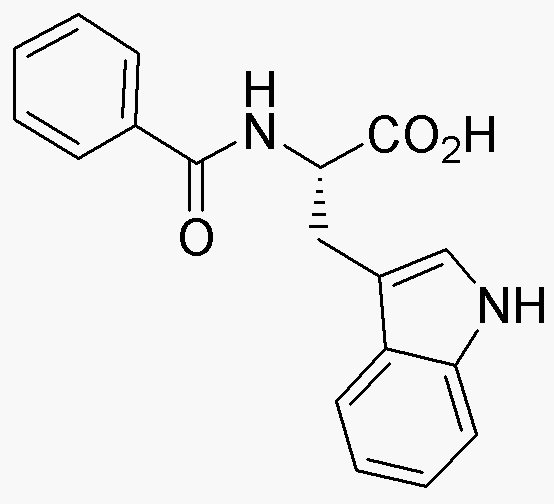Na-Benzoyl-L-tryptophan is widely utilized in research focused on:
- Pharmaceutical Development: This compound is used as an intermediate in the synthesis of various pharmaceuticals, particularly those targeting neurological disorders, due to its ability to influence serotonin pathways.
- Biochemical Research: It serves as a tool in studying protein interactions and enzyme activities, helping researchers understand metabolic pathways and cellular functions.
- Food Industry: Na-Benzoyl-L-tryptophan is explored for its potential as a natural preservative, leveraging its antioxidant properties to enhance food shelf life.
- Cosmetic Formulations: The compound is incorporated into skincare products for its moisturizing and skin-soothing properties, making it beneficial for sensitive skin formulations.
- Clinical Nutrition: It is being investigated for its role in dietary supplements aimed at improving mood and cognitive function, appealing to consumers seeking mental wellness solutions.
General Information
Properties
Safety and Regulations
Applications
Na-Benzoyl-L-tryptophan is widely utilized in research focused on:
- Pharmaceutical Development: This compound is used as an intermediate in the synthesis of various pharmaceuticals, particularly those targeting neurological disorders, due to its ability to influence serotonin pathways.
- Biochemical Research: It serves as a tool in studying protein interactions and enzyme activities, helping researchers understand metabolic pathways and cellular functions.
- Food Industry: Na-Benzoyl-L-tryptophan is explored for its potential as a natural preservative, leveraging its antioxidant properties to enhance food shelf life.
- Cosmetic Formulations: The compound is incorporated into skincare products for its moisturizing and skin-soothing properties, making it beneficial for sensitive skin formulations.
- Clinical Nutrition: It is being investigated for its role in dietary supplements aimed at improving mood and cognitive function, appealing to consumers seeking mental wellness solutions.
Documents
Safety Data Sheets (SDS)
The SDS provides comprehensive safety information on handling, storage, and disposal of the product.
Product Specification (PS)
The PS provides a comprehensive breakdown of the product’s properties, including chemical composition, physical state, purity, and storage requirements. It also details acceptable quality ranges and the product's intended applications.
Certificates of Analysis (COA)
Search for Certificates of Analysis (COA) by entering the products Lot Number. Lot and Batch Numbers can be found on a product’s label following the words ‘Lot’ or ‘Batch’.
*Catalog Number
*Lot Number
Certificates Of Origin (COO)
This COO confirms the country where the product was manufactured, and also details the materials and components used in it and whether it is derived from natural, synthetic, or other specific sources. This certificate may be required for customs, trade, and regulatory compliance.
*Catalog Number
*Lot Number
Safety Data Sheets (SDS)
The SDS provides comprehensive safety information on handling, storage, and disposal of the product.
DownloadProduct Specification (PS)
The PS provides a comprehensive breakdown of the product’s properties, including chemical composition, physical state, purity, and storage requirements. It also details acceptable quality ranges and the product's intended applications.
DownloadCertificates of Analysis (COA)
Search for Certificates of Analysis (COA) by entering the products Lot Number. Lot and Batch Numbers can be found on a product’s label following the words ‘Lot’ or ‘Batch’.
*Catalog Number
*Lot Number
Certificates Of Origin (COO)
This COO confirms the country where the product was manufactured, and also details the materials and components used in it and whether it is derived from natural, synthetic, or other specific sources. This certificate may be required for customs, trade, and regulatory compliance.


